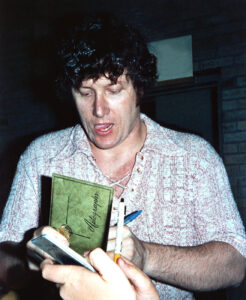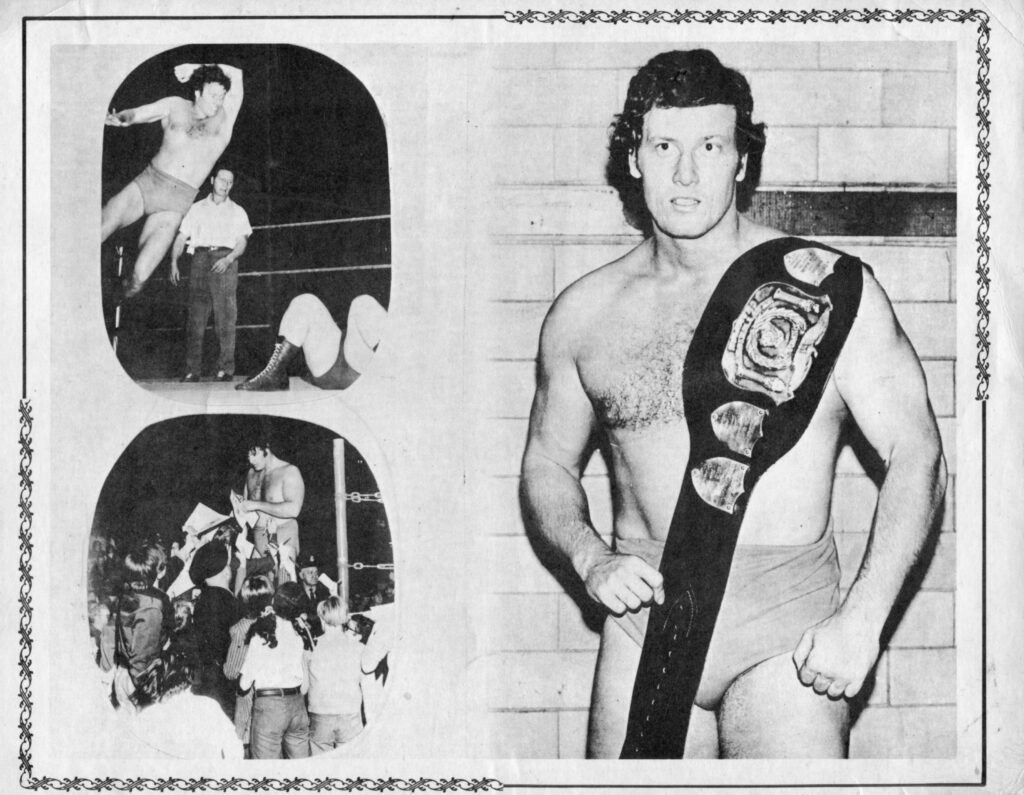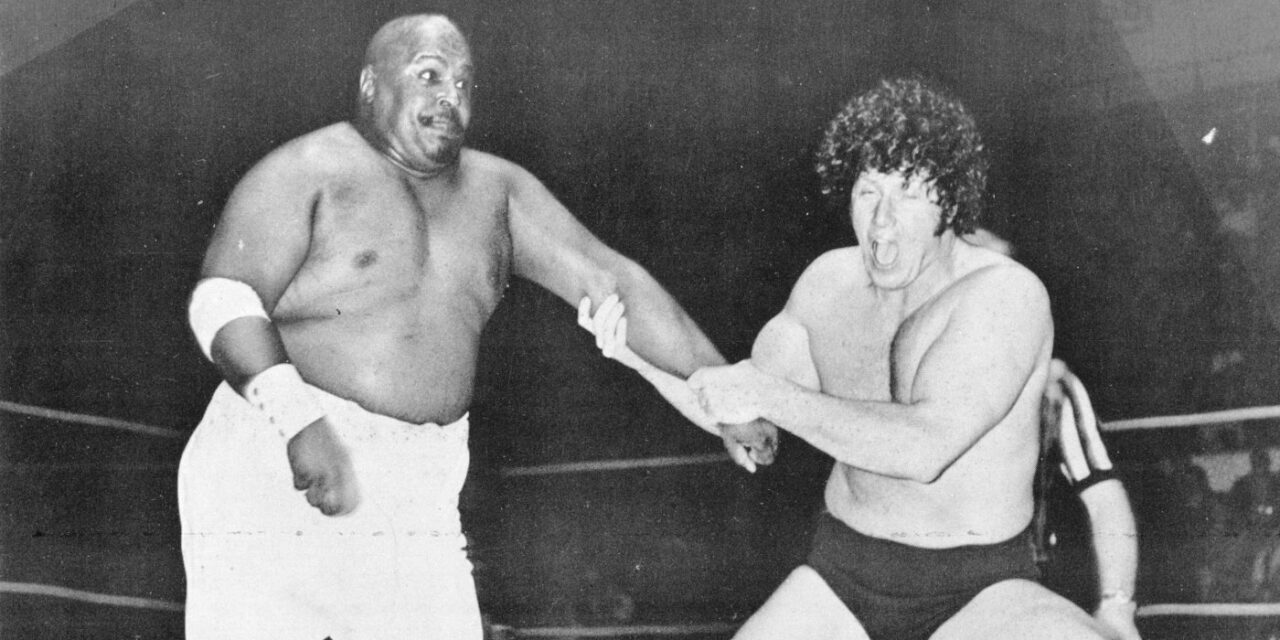I always thought it was incongruous that Johnny Powers, the rugged hero of my youth, a man who was the LeBron James of his time in Cleveland, a man who had Maple Leaf Gardens on its feet in a brutal main event with Johnny Valentine, would watch his North American career peter out in a North Carolina elementary school auditorium.

Johnny Powers in 1973. (Photo By Steven Johnson)
So, working with SLAM! and my colleague Greg Oliver, I asked him about it. His answer explained a lot about the mind of the wrestler-promoter-entrepreneur, who died Dec. 30 at 79. “From an early age I’ve been relentless in challenging myself,” he said. “When you’re challenging yourself, failures will come. It’s hard, you learn from them. I think there was a sadness in me.”
“Challenging myself.” “Failures.” Johnny Powers challenged himself a lot in the wrestling business, trying to breathe life into dormant promotions, going head to head with the wrestling establishment, or taking his career overseas. He had his share of failures, too. In his own words, he was “a headstrong young man” and a lot of wrestlers went at him over his management style. His bankruptcy wiped out much of the goodwill he had in Cleveland, and his efforts to promote wrestling in an area in the grip of Carolinas promoter Jim Crockett fell flat.
I had thought those were among the reasons that Powers kept a low profile after he left wrestling. I suspected there was some level of embarrassment for a man who certainly had the look, style, and name to be a top champion, and was for a period of time. (Dennis Waters chose his ring name because he liked John Wayne and liked the word powerful.) He was notoriously hard to pin down and kept in contact with few old-timers, Reggie Love being the main exception.
He retired from wrestling in 1982, surfacing infrequently, at a show in Buffalo honoring the late Ilio DiPaolo and at a breakfast at the Toronto Board of Trade in 2001 with then-Minnesota Gov. Jesse Ventura. We’re not aware of any substantive interview he conducted until he talked with Greg in 2002 for The Pro Wrestling Hall of Fame: The Canadians, and even then, he was guarded. “I am actually a very private guy,” he said. “When I retired, I said I was going to step away from the business. It wasn’t an ego thing. It was just a segregated life thing, so I’m actually quite private about my numbers and emails and stuff like that.”
So there was no embarrassment, after all. He had just gone in different directions like he had when he went from a wrestler to a television producer to a real estate broker to a mixed martial arts promoter to a venture capitalist to whatever “challenged” him at the moment. As he explained it to me: “I got into the business so early. My first matches were at 17, I turned pro at 20. By 21, I was wrestling Bruno Sammartino and by 24 I was going into Japan, and by 24 I was also running the first international syndication of television shows, National Sports Television. So there was this need for me to forge ahead.”
Some of his business endeavors never got off the ground, others fared very well; either way, he was always looking inquisitively for an angle in the private sector just as he had in wrestling. He had a restless and creative mind and once you accepted that, and tossed away the normal wrestling questions of your favorite match or your favorite opponent, he was among the most incisive analysts of the sport.
Greg and I have tens of thousands of words on him in our files and that doesn’t count the hundreds of pages we received under a Freedom of Information Act request about his legal fights with Crockett, the basis for a chapter in The Pro Wrestling Hall of Fame: The Storytellers. In the “now it can be told” category: Powers was 25 when he bought the rights to promote Akron, Ohio, for $5,000 from Pedro Martinez of Buffalo. Under the deal, he’d get back whatever he didn’t lose of that amount, which was about $1,700. He called Martinez to ask for the money, a considerable amount 45 years ago and got an unexpected response. “He said, ‘Well, I processed it. I had to pay my girlfriend’ — he called it a secretary but it was a girlfriend because he hired secretaries who were his girlfriends — ‘I had to pay my girlfriend’s rent and her telephone bill.’ That was my money!”

This promo cost 50 cents back in the day.
Despite that, Martinez, a wily promoter in upstate New York, considered Powers like a son and the feeling was mutual. Powers was a bleached blond heel in Buffalo in the mid-1960s, when the territory dried up. He fared well elsewhere, particularly in the American Wrestling Association, before returning to the steel belt area of Ohio, Pennsylvania, and New York as Martinez’s business partner in the late 1960s. Eventually, he would run the Cleveland end of the operation and Martinez would run Buffalo with his son, Ron. When Powers was not traveling, he liked to stay with his mom and dad in Hamilton, Ontario. “When I’d walk in the door my mom would say, ‘Eh, you’ve been with Pedro, haven’t you?’ ‘Why mom?’ ‘You look so frustrated, you’re shaking your head, have you been shaking your head all the way from Buffalo – that’s like an hour and a half?’”
The answer was yes; Powers was trying to figure out why his investment in the Ohio region had gone south, yet Martinez forgave the debt. “He gave me half back again because he said, ‘I’ve never met a working fool like you who works so hard and is honest and is actually very creative and I’m going to give it back and you can do the work.’” Wrestling in the region popped big-time from 1970 to 1973, with Powers as world champion, a title that came from a fictitious victory against Fred Blassie in California. With that success, Powers looked to expand his brand, opening a health club in Cleveland and investing heavily in a nascent roller derby league in 1972-73. He had too many projects going on at the same time and ended up in bankruptcy in the summer of 1973, about the same time wrestling cooled off in the area, particularly when the downtown Cleveland Arena closed in favor of a large coliseum on the outskirts of town. It made a splash in the newspapers, but Powers was candid about it to the point of acknowledging two workers rented a moving truck for him because he was out of cash. He could have been talking about wrestling or business when he told the Cleveland Plain-Dealer: “You like to get hit because there is a challenge.”
That didn’t matter to me at the time. My major concern was that he always raced to the ring, so it was hard to get a good picture of a moving target with an Instamatic camera and a flashcube. April 1972 in Cleveland: He tore past fans to get at Waldo von Erich and Luke Graham at a tag match. January 1973 in Buffalo: He tore past fans to get at von Erich again. March 1973 in Jamestown, N.Y.: He raced past me in a high school gym to get at Eric the Animal. August 1973 in Toronto: He raced down the famous ramp to get at Johnny Valentine. (I’d upgraded my camera by then, so it worked out better.) I told him about my photography frustrations later on, and he explained there was a purpose to his onrushes. He wanted to be the only wrestler on the card who raced to the ring, to show how ready he was for the fight, how he was the aggressor and prepared for action right away. It would set the mood for the event. It was a matter of knowing your audience. It was marketing.
He had learned about marketing in 1965-66 as a member of Simpsons-Sears Sports Advisory Council in Canada. Remember, he was only 22 at the time. Simpsons-Sears put together a blue-ribbon group to develop and endorse specific lines of equipment and promote physical fitness across Canada. Powers had a fitness line with barbells and dumbbells, and designed an isometric fitness program for hockey, going across Canada to store openings.
“It was the first time I learned the concept of retail marketing. I was starting to learn a little bit about promotion from my own interests but I got picked up by this and now all of a sudden I’m seeing how products are endorsed and promoted and all of the rest of the stuff,” he said. The Sears promotion also gave Powers an opportunity to explain his profession to the outside world for the first time. “They’d say, ‘Well, Johnny Powers, what about the fake business?’” he recalled. “At that time I didn’t think I needed the marketing business and I’d say, ‘Off the record, fuck you. On the record, fuck you too.’ But why don’t you ask me, ‘Can I create a character? Do I sometimes pull a punch so I don’t hurt a guy and lose the next match with him or whatever, because he can’t show up because he had a broken jaw? Why don’t you ask me a few sensible things instead of coming at me with a blanket statement?’”
That’s how Greg and I got to where we were with him, by asking a few sensible things. After much gentle prodding, Powers appeared at Greg’s Titans in Toronto banquet in 2004, where we talked extensively and relations became warm, especially when I supplied him with a copy of the “Go, Johnny, Go!” song that announcer Bob Finnegan put together for him circa 1973. He explained the marketing principles behind the legendary 1974 riot in Cleveland precipitated when he turned Ernie Ladd into a babyface (over Ladd’s protests) based on audience research. We listened to his creative concepts, such as the muscular bald man and discarded Hollywood prop he turned into a chariot racer to ferry wrestlers to the ring at an extravagant outdoor show in Cleveland in 1972. He brought Antonio Inoki to wrestle in Cleveland in 1974 during their fight for the National Wrestling Federation belt; he saw a new opportunity and it would be years before anyone understood how far that was ahead of its time.
Even if his ventures did not pertain to wrestling, they were born of the things he learned from the sport. Case in point: In the late 1970s, Powers found an ideal spot for a waterslide park, which was becoming a big thing in those days, at an old arcade at Folly Beach in South Carolina. He had financing lined up through savings and loan institutions just as they put loans on hold to protest a state usury cap law. “It was Folly Beach, South Carolina, and it turned out to be a real folly,” he said. In that context, winding down his North American wrestling career at low levels in the Carolinas after the unsuccessful attempt to compete with Crockett’s promotion made all the sense in the world. It was a challenge, whether it succeeded or failed, and Johnny Powers loved to challenge himself.
RELATED LINKS
- Jan. 7, 2023: Johnny Powers photo gallery
- Jan. 7, 2023: Johnny Powers dead at 79
- July 10, 2007: Powers gives MMA promoting a try
Steven Johnson is co-author of The Pro Wrestling Hall of Fame series with Greg Oliver and is finishing a biography of Jim Londos. Reach him at @steelbeltsteve on Twitter or blakeslee_74@yahoo.com.

